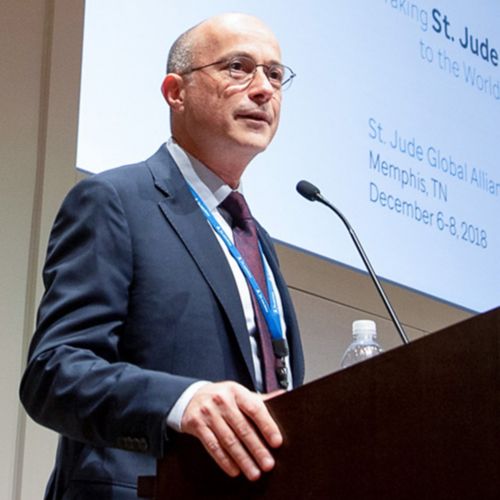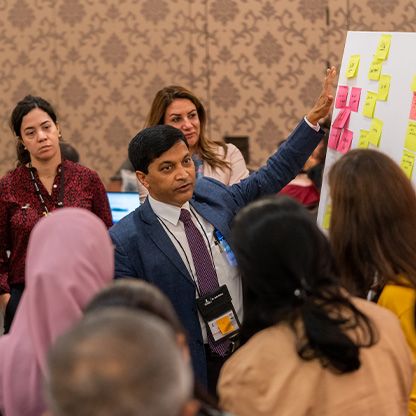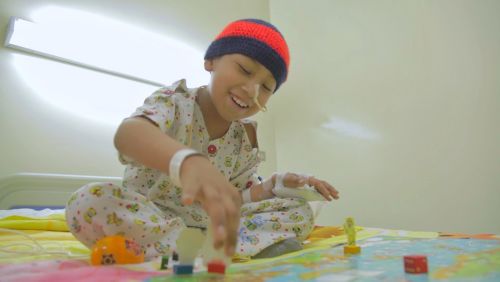St. Jude Family of Websites
Explore our cutting edge research, world-class patient care, career opportunities and more.
St. Jude Children's Research Hospital Home

- Fundraising
St. Jude Family of Websites
Explore our cutting edge research, world-class patient care, career opportunities and more.
St. Jude Children's Research Hospital Home

- Fundraising
Global Scholars: Dr. Adriana Porras Moreno
Other Global Scholars Projects:
Lack of specialists was Dr. Porras’s inspiration to develop sickle cell program in Costa Rica
As a 5-year-old girl, growing up in the Costa Rican city of San Jose, Dr. Adriana Porras Moreno dreamed of one day running her own pulperia. Pulperias are little corner stores — places to stop in and pick up a wide range of essentials, from soap, to clothes, to baby bottles.
Porras grew up across from a pulperia and pictured herself becoming a business owner. She imagined herself behind the counter selling items. “And then,” she says, with a laugh, “I could eat things when there were no customers at the store.”
But her need for medical treatment as a child set her on a different path. Porras began to trip and fall, more and more frequently.
Her mother took her to a doctor, then an orthopedist. She was prescribed orthopedic shoes and correction bands to keep her feet from pointing inward. Although she remembers some classmates teasing her and calling her names, it was these shoes that led her to medical school.
“I decided that I wanted to be a doctor,” she remembers. “Everything that I did, from kindergarten, all the way to university, was with a goal in mind that I will one day become a doctor.”
Fast forward to today, and she has done just that. Porras blazed a path from Costa Rica to the United States and back. She is now an attending physician in the Hematology Oncology Department at the National Children’s Hospital in her hometown of San Jose.

“I’m trying to build a program to educate the other general physicians who, like me, are dealing with young sickle cell disease patients.” -- Dr. Adriana Porras Moreno
Porras is also part of the first cohort of Global Scholars earning a Master of Science in Global Child Health from the St. Jude Children’s Research Hospital Graduate School of Biomedical Sciences. Her Global Scholars Project focuses on enhancing the treatment and care of sickle cell disease for pediatric patients.
“Right now, in Costa Rica we don’t have enough capacity to develop a lot of specialists,” she says. “I’m trying to build a program to educate the other general physicians who, like me, are dealing with young sickle cell disease patients.”
This idea arose, in part, out of the COVID-19 pandemic. Sickle cell patients sometimes travel for six hours to appointments at the National Children’s Hospital. But during pain crises, patients often turn to their local clinics. That was also the case during the pandemic as families faced economic challenges or avoided larger hospital settings.
“They go to these other places where knowledge of sickle cell disease is really poor,” she says. “The parents are the ones who have to tell the doctors what sickle cell is. I want to prevent somebody dying because of this.”
Through her Global Scholars Project, Porras is building a continuing education program for general physicians, pediatricians, nurses and others. She will collect data on existing knowledge about sickle cell disease and then develop an online program so clinicians can learn at their own pace without having to travel.
Another goal of her project is to enhance communication among medical professionals. During the pandemic, Porras says, local clinicians would sometimes change patients’ medication but not provide instructions for how to use it. “We want to let community healthcare providers know, as part of the continuing education class, that they can call specialists and ask anything.”
Porras has identified other project goals. They include making medicine easier to administer by changing some from pill form to liquid or expanding the age of patients eligible for specialty services. “Right now, we are only treating children under 13 years old, and we are supposed to be treating them until 18. But we need more resources and more space, and a lot of other things,” Porras says.
Patients with sickle cell disease have always captured Porras’ heart. She responds to the pain they face, the kindness of the families and the distance many must travel for specialty medical care.
Looking ahead, Porras sees the potential for adding phases to her program, perhaps geared toward social workers and psychologists, to address the ripple effects of the disease. She points to one young boy whom she helped to find a new school because classmates had been teasing him about the yellow tint to his eyes.
“He’s now a happy kid,” she says.
And in that sense, he may have found something of a kindred spirit in the doctor who once faced elementary school teasing for her orthopedic shoes and correction bands. The doctor who first learned the power and possibilities of medicine at a very young age – and then set out to change the lives of young children across her country.


